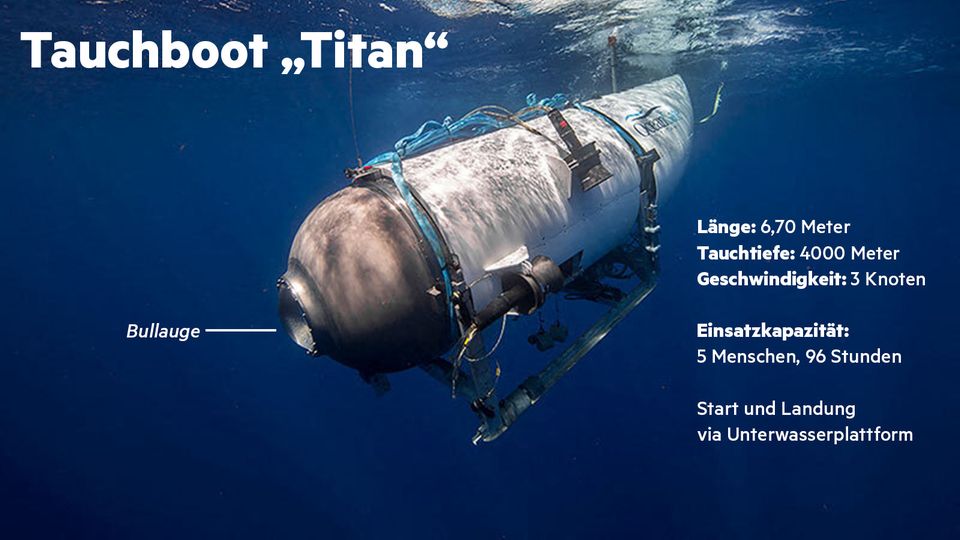Lost submersible
Search for “Titan” on the water surface so far unsuccessful – now rescuers are concentrating on the depths of the Atlantic
The “Titan” was supposed to go down to the wreck of the “Titanic”.
© Woods Hole Oceanographic Institution / AFP
The race against time goes on – and is now increasingly being continued under water. In the search for the missing “Titanic” expedition submersible “Titan”, the rescuers struggle with adverse conditions.
Rescuers race against the clock to locate a five-person submersible near the famous wreckage of the Titanic. On board is, among others, the French researcher Paul-Henri Nargeolet, who is considered one of the most well-known experts on the wreck and is therefore nicknamed “Mr Titanic”. Other inmates include British adventurer Hamish Harding and British-Pakistani business consultant Shahzada Dawood and his 19-year-old son Suleman. The identity of the Fifth was not initially confirmed (read more about the people on board here).
Search for “Titan” increased underwater
The search under water is being intensified, said John Mauger from the US Coast Guard to the US broadcaster CNN. Initially, the focus was on the water surface by flying over a large area with aircraft following a specific pattern. US National Guard planes and planes from Canada would have supported the US Coast Guard. On Tuesday, the search will be increased under water in the hope of being able to locate the submersible. An area of around 26,000 square kilometers had already been searched, the US arts guard said via short message service Twitter.
The vehicle has been missing since Sunday morning (local time) – about an hour and 45 minutes after the start of the dive, contact with the escort boat “Polar Prince” broke off. According to the provider Oceangate Expeditions, the almost seven meter small “Titan” has enough oxygen for 96 hours. But experts were pessimistic about the chance of finding the vehicle in time.
A rescue cannot be attempted until the boat is located. The wreck of the Titanic, broken in half, lies at a depth of around 3800 meters. The conditions are extremely difficult at the site about 684 kilometers south of the Canadian island of Newfoundland. It is pitch black and the water pressure is great.
Oceangate offers wealthy customers an adventurous trip – the cost for the eight-day expedition is around 250,000 US dollars (229,000 euros). The dive itself only lasts a few hours. The company is promoting the carbon fiber submersible rides as a chance to “step out of the ordinary and discover something truly extraordinary,” according to the BBC. Experts and researchers are always on board.

Info sheet for the submersible “Titan”: The tourists travel in this underwater vehicle
© Oceangate / ABACA / star infographic / ros
Reporter David Pogue from the US broadcaster CBS, who took part in the trip last year, told the BBC that the vehicle made an improvised impression on him. “You control this submarine with an Xbox game controller,” Pogue said. Part of the ballast consists of construction pipes. If the boat gets stuck or leaks, “there’s no backup, no escape pod,” he said. Former submarine officer Frank Owen told the BBC the biggest challenge for those trapped was staying calm and not using too much oxygen.
Probably difficult conditions on board the dive boat
With expert Nargeolet, a former Navy diver, and adventurer Harding, there are at least two experienced inmates on board. The Briton, who will be 59 in a few days, holds several Guinness World Records, including the longest dive in the Mariana Trench, the deepest place on earth, in March 2021. In June 2022 he flew into space. Harding’s company, Action Aviation, said the family was grateful for the many messages of support. One is very proud of Harding, who was responsible, among other things, for the reintroduction of cheetahs from Namibia to India.
Up to 300 meters deep
A submarine faster than a dolphin: With this underwater Ferrari, the super-rich are supposed to explore the seas
According to an expert, the conditions in the submersible are extremely difficult. “It’s going to be hot, it’s going to be cramped,” oceanologist Simon Boxall of the University of Southampton told the BBC. “There is no escape pod.” There is enormous pressure at this depth, and it is impossible to get out. “So they are totally dependent on the submersible being found.” Boxall stressed, “It’s a tremendous challenge that we’ve never faced before.” The time for a rescue is very short.
Oceanographer David Mearns told the BBC a commercial pipe-laying vessel has now arrived in the area. The ship is very capable and it is hoped it will have the ability to reach the depth needed to search for the submersible.
The “Titanic” sank in the North Atlantic on its maiden voyage from Southampton to New York in 1912, killing more than 1,500 of the 2,200 people on board. The remains of the famous luxury liner were discovered in 1985. Films such as the blockbuster “Titanic” (1997) with Hollywood stars Kate Winslet and Leonardo DiCaprio further fueled interest in the disaster. Only recently, with the help of high-resolution 3D images, scientists offered the most accurate depiction of the wreck to date.

